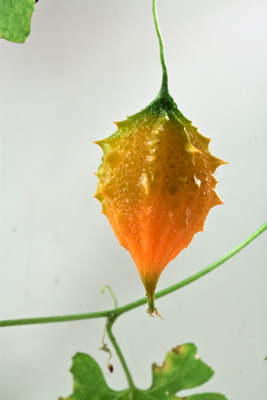Every spring and summer I see beautiful, pendulous orange orbs hanging from my hedges. At first I was curious about a new plant. Then as a Miami resident who has regretted letting invasive plants grow unchecked, I became suspicious: What is this strange plant and what does it want?
Called balsam pear or balsam apple, the botanical name is Momordica charantia. It is an annual or short-lived perennial vine native to sub-Saharan Africa, and apparently introduced into warmer areas of the Americas.
The balsam pear is within the Cucurbitaceae family of plants, along with friends like cucumbers, gourds, luffa, squash, pumpkin and zucchini. This relationship can help you identify the balsam pear because it produces a fruit somewhat reminiscent of a gourd or zucchini.

Balsam pear fruit. Kenneth Setzer/FTBG.
Watch for the vine to grow on bushes and hedges. Its leaves are deeply palmate — think outstretched hand — and usually have five to seven lobes; this is probably unlike the foliage of whatever the balsam pear chooses to grow upon, so you can spot it by the “hand-like” leaves. Some sources state the leaves are bad-smelling, but I actually find their smell pleasant.
After trailing all over your plants, hedges, fences or any other supports it can entwine its tendrils onto, the vine will produce small but attractive bright yellow flowers. They have a papery look to them, and resemble other flowers in the gourd family.
The real warning sign you’ve got balsam pear is the fruit. The fruits are just plain weird; they remind me of alien pods from a sci-fi film. They really stand out from the surrounding green as they dangle like an old-time train conductor’s lantern. They start out green but mature to a bright citrus orange. At this stage they resemble warty orange sort-of-pear-shaped pendants, about one to one and a half inches long.
Eventually the fruit will open, splitting into three parts to reveal the seeds inside a sticky, deep red pulp. The vines can grow to over 15 feet long and may flower for up to six months.
There are actually about 40 species in the Momordica genus, many of which are cultivated for their fruit, particularly in tropical Asia where it is often called bitter gourd. In parts of western Africa, the young fruits are eaten as emergency food. The mature fruits of wild plants are said to be poisonous.
All parts of the plant are also enlisted for multiple medicinal uses and folk medicine like ridding people and livestock of parasites. Though extracts of the plant are being looked at for use in everything from fighting diabetes to HIV, I would not eat it, especially living in a part of the world able to grow delicious treats like oranges and mangos.
None of these characteristics necessarily poses a problem. The problem is light. This vine, like other plants, needs it to make its food, and in its battle to reach the life-giving light of the sun, it tends to cover everything in its way. Since it is a vine, it has no real support of its own, so climbs over other things, eventually covering other plants with a thick layer of balsam pear. This can deprive the supporting plant of light, not to mention weighing it down.
The best method for removal is to simply pull it off your plants. Do not yank it off, or it will break quickly. If you pull slowly, you will get more of the balsam pear off intact. If you can trace the source of the vine to the ground, pull it out. While it’s not horribly invasive, removing it will give your plants one less problem to deal with.
